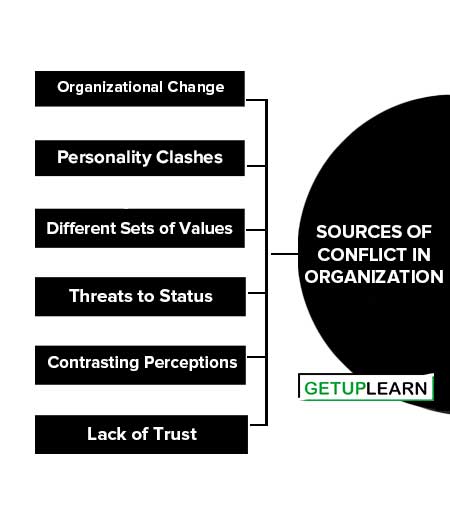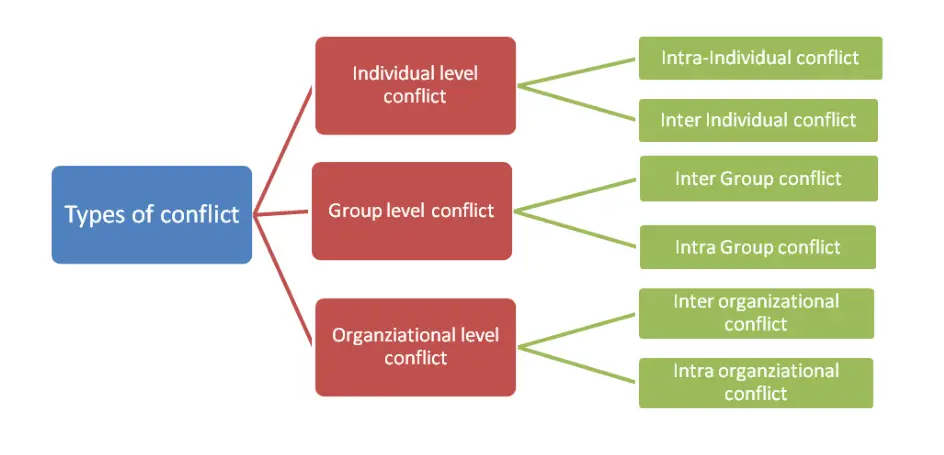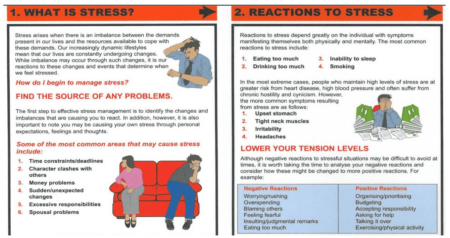Table of Contents
What is Organizational Conflict?
Conflict refers to a disagreement, opposition, or struggle between two or more individual groups. It results from incompatible influence attempts between and within individuals, groups, or organizations.
Conflict occurs whenever disagreements exist in a social situation over issues (work-related or personal). Conflict is a process that begins when one party perceives that another party has negatively affected, or is about to negatively affects, something that the first party cares about (Thomas, 1992).
Conflict can be either constructive or destructive. Constructive conflict prevents stagnation, stimulates creativity, and allows tensions to be released.
However, excessive levels of conflict can hinder the effectiveness of a group or an organization lessen the satisfaction of group members, increase absence and turnover rates, and lower productivity. Functional constructive forms of conflict support the goals of the group and improve its performance.
Definition of Conflict in Organization
These are the following simple definitions of conflict in organization:
Conflict is behaviour by a person or group that is purposely designed to inhibit the attainment of goals by another person or group. This ‘purposeful inhibition may be active or passive.
Gray and Starke
As any situation in which incompatible goals, attitudes, emotions or behaviours lead to disagreement or opposition between two or more parties.
R. W Woodman
Conflict is a process that begins when one party perceives that another party has negatively affected, or is about to negatively affects, something that the first party cares about.
Thomas
Conflict is the appearance of difference, difference of opinions, of interests.
Follett
Nature of Conflict in Organization
In the context of an organization, the broad features of a conflict are as under:
- Conflict occurs when individuals are not able to choose among the available alternative courses of action.
- The conflict between two individuals implies that they have conflicting perceptions, values, and goals.
- Conflict is a dynamic process as it indicates a series of events. Each conflict is made up of interlocking conflict episodes.
- Conflict must be perceived by the parties to it. If no one is aware of a conflict, then it is generally agreed that no conflict exists.
Sources of Conflict in Organization
These are the sources of conflict in organizations explained below:
- Organizational Change
- Personality Clashes
- Different Sets of Values
- Threats to Status
- Contrasting Perceptions
- Lack of Trust

Organizational Change
People hold differing views over the direction to go. With the routes to take and their political and social change increasing and the marketplace hurting toward a global economy, organizational changes will be ever-present.
Personality Clashes
The concept of individual differences is fundamental to organizational behavior. Not everyone thinks feels, looks, or acts alike.
Although personality differences can cause conflict, they are also a rich resource for creative problem-solving. Employees need to accept, respect, and learn how to use these differences when they arise.
Different Sets of Values
People also hold different beliefs and adhere to different value systems. Their philosophies may diverge, or their ethical values may lead them in different directions. The resulting disputes can be difficult to resolve since they are less objective than disagreements over alternative products, inventory levels, or promotional campaigns.
Threats to Status
The status, or the social rank of a person in a group, is very important to many individuals. When one’s status is threatened, face-saving becomes a powerful driving force as a person struggles to maintain a desired image. Conflict may arise between the defensive person and whoever created a threat to status.
Contrasting Perceptions
People perceive things differently as a result of their prior experiences and expectations. Since their perceptions are very real to them (and they feel that these perceptions must be equally apparent to others),
They sometimes fail to realize that others may hold contrasting perceptions of the same object or event. Conflict may arise unless employees learn to see things as others see them and help others to do the same.
Lack of Trust
Every continuing relationship requires some degree of trust-the capacity to depend on each other’s words and actions. Trust opens up boundaries, provides opportunities in which to act, and enriches the entire social fabric of an organization.
It takes time to build, but it can be destroyed in an instant. When someone has a real or perceived reason not to trust another, the potential for conflict rises.
Issues Involved in Conflict
The nature of conflict varies according to the kind of issue on which people disagree. There are four basic issues that may be involved in a conflict either exclusively or jointly with others. These issues are:
-
Facts: Conflict may occur because of disagreement that the persons have different definitions of a problem, relevant facts related to the problem, or their authority and power.
-
Goals: Sometimes the disagreement may be about what should be accomplished- the desirable objectives of a department, division, section, or of a specific position within the organization.
-
Methods: Individuals differ about the procedures, strategies, or tactics which would most likely achieve a mutually desired goal.
- Values: Sometimes, the disagreement is over ethics, the way power should be exercised, or moral considerations or assumptions about justice, fairness, and so on. Such differences may affect the choice of either goals or methods.
Outcomes of Conflicts
Some types of conflict encourage new solutions to problems and enhance creativity in organizations. In these cases, managers will want to encourage conflicts. Functional conflicts are conflicts that support the goals of the group and improve its performance. There are also conflicts that hinder group performance.
These are dysfunctional or destructive forms of conflict. Therefore, managers should stimulate functional conflict and prevent or resolve non-dysfunctional conflict. This is the key to conflict management. The consequences of conflict can be positive or negative, as shown below:
| Positive Consequences | Negative Consequences |
| 1. Leads to new ideas. | 1. Diverts energy from work. |
| 2. Stimulates creativity. | 2. Threatens psychological well- being. |
| 3. Motivates Change. | 3. Wastes resources |
| 4. Promotes organizational vitality. | 4. Creates a negative climate. |
| 5. Helps individuals and groups establish identities. | 5. Breaks down group cohesion. |
| 6. Serves as a safety valve to indicate problems. | 6. Can increase hostility and aggressive behaviors. |
Functional Vs. Dysfunctional Conflict
Functional Conflict
Functional, constructive forms of conflict support the goals of the group and improve its performance. Conflicts that hinder group performance are dysfunctional or destructive forms of conflict. Task conflict relates to the content and goals of the work.
Low-to-moderate levels of task conflict are functional and consistently demonstrate a positive effect on group performance because it stimulates discussion, improving group performance.
Dysfunctional Conflict
There are conflicts that hinder group performance and are therefore known as dysfunctional or destructive forms of conflict. Dysfunctional conflict is an unhealthy, destructive disagreement between two or more people.
A key for recognizing a dysfunctional conflict is that ITO origin is often emotional or behavioral. Disagreements that involve personalized anger and resentment directed at specific individuals rather than specific ideas are dysfunctional. In a dysfunctional conflict, the losses in both parties may exceed any potential gain from the conflict.
Types of Conflicts in an Organization
These are the important types of conflicts in an organization:
- Intra-Individual Conflict
- Vertical Conflict
- Horizontal Conflict
- Intragroup Conflict
- Intergroup Conflict
- Organizational Conflict
- Inter-Organizational Conflict

Individual Level Conflict
The analysis of conflict may start at the individual level itself. Since an organization is composed of various individuals, many conflicts develop at the individual level. The individual-level conflict may be analyzed in two ways:
- Intra-Individual Conflict
- Goal Conflict
- Role Conflict
Intra-Individual Conflict
Though conflict requires two parties, it may also take place within an individual itself. Conflict at the intrapersonal level occurs because a smooth progression of the need-driven-goal cycle does not occur in reality.
Within every individual, there are a number of competing roles and goals. Thus, an individual experiences two types of conflict in himself: goal conflict and role conflict.
Goal Conflict
A common source of conflict for an individual is a goal that has both positive and negative features, or two or more competing goals. Goal conflict occurs when two or more goals block each other. There can be three alternatives to goal conflict: approach-approach, approach-avoidance, and avoidance-avoidance conflict.
Role Conflict
An individual performs a number of roles. Although all the roles which he brings into the organization are relevant to his behavior, in the study of organizational behavior, however, his organizational role is more important.
In the organization, every person is expected to behave in a particular manner while performing a specific role. When expectations of a role are materially different or opposite from the behavior expected by the individual in that role, he tends to be in role conflict because there is no way to meet one expectation without rejecting the other.
Inter-Individual Conflict
Inter-personal conflicts arise between two individuals having competition for achieving scarce things, such as status, power, position, promotion, or resources or they may pick up conflict due to their divergent opinions, attitudes, or values. Disagreement among individuals in an organization may arise for a variety of reasons:
- Personal differences i.e. everyone has a unique background because of his or her upbringing, cultural and family traditions, and socialization processes.
- Information deficiency i.e. communication breakdown in the organization,
- Role incompatibility tasks are highly interdependent.
- Environmental stress shrinking resources, downsizing, competitive pressures, or high degrees of uncertainty. Interpersonal conflicts may be interpreted in two forms:
Vertical Conflict
A vertical relationship, which is mostly in the form of a superior-subordinate relationship, results in vertical conflicts which usually arise because the superior attempts to control the behavior of his subordinates, and subordinates resist such control.
A subordinate may resist such control as he feels that his superior tries to control activities outside the scope of his control and he perceives conflict with his superior and the latter may feel when his attempt of control is let down.
Horizontal Conflict
Horizontal conflict at the interpersonal level is among persons at the same hierarchical level in the same function or in different functions. Within each functional group, there may be many individuals and these individuals interact among themselves.
Such interactions may be contacts for the purpose of giving, taking, and soliciting advice, counsel, information, and skilled assistance on difficult problems. These interactions may be cooperative or conflicting depending on the nature of the persons involved in the interaction and situational variables.
Group Level Conflict
Conflict may occur at the group level. A group constitutes two or more persons who interact in such a way that each person influences and is influenced by others. Groups exist in every organization and they affect the behavior of their members.
They not only affect the behavior of their members, rather, they have an impact on other groups and the organization as a whole. In this interaction process, there may be two types of conflict: intragroup (within the group), and intergroup (between the groups).
Intragroup Conflict
Intra-group conflict may be thought of in terms of group characteristics and, to some extent, interpersonal conflict, especially if two persons are from the same group.
A group consists of a number of persons whose interactions at a given time generate a system of values, norms, and sanctions appropriate to the nature of the task on which they are working, which has created a set of well-defined roles and status relations that are interdependent. Intra-group conflict may arise in three situations:
- When the group faces a novel problem the task;
- Where new values are imported from the social environment into the group; and c. Where a person’s extra-group role comes into conflict with his intra-group role.
Intra-group conflict is visualized more when people come from different socio-economic backgrounds and have different political and religious views.
Intergroup Conflict
Inter-group conflict arises out of the interaction of various groups. There are many factors in the organization, which determine intergroup relations. These factors can influence relations between two or more groups. If these factors are not positive, they tend to create conflict among groups. These factors are:
Competition for Resources
Most organization today has very few resources. Groups within the organization compete for budget funds, space, supplies, personnel, and support services.
Task Interdependence
If two groups in the organization depend on one another in a mutual way or even a one-way direction (as in a sequential technological process), there tends to be more conflict than if groups are independent of one another. The more diverse the objectives, priorities, and personnel of the interdependent groups (e.g. research and production), the more conflict there tends to be.
Jurisdictional Ambiguity
This may “turf” problems or overlapping responsibilities. For example, conflict might occur when one group attempts to assume more control or take credit for desirable activities, or give up its part and any responsibility for undesirable activities.
Status Struggles
This conflict occurs when one group attempts to improve its status and another group view this as a threat to its place in the status hierarchy. One group may also feel it is being inequitably treated in comparison with another group of equal status in terms of reward, job assignments, working conditions, privileges, or status symbols.
Organizational Conflict
Conflicts at the individual level may be or at the group, level is all inherent in organizational-level conflict. Conflict at the organizational level may be intra-organizational or inter-organizational.
Intra Organizational Conflict
Intra-organizational conflicts may be again in various forms, for example, at the individual level, and at the group level. Since these are all parts of the organization; the conflicts among them are of much concern to the organization. The reasons for conflicts in an organization are many but mainly three kinds of internal strains can be identified:
Horizontal Conflict
Horizontal conflict refers to conflict between employees or departments at the same hierarchical level in an organization. The source of conflict between departments consists of pressures toward sub-optimization. Each department may sub-optimize by independently trying to achieve its own departmental goals.
Vertical Conflict
Vertical conflict separates people at various levels of the occupational ladders in the organization. It refers to any conflict between different levels in an organization. It occurs usually in superior-subordinate relations.
Line and Staff Conflict
Controversy and conflict are inherent in the concept of line and staff. It is not an easy task to divide and distribute expertise, authority, and roles in equitable quantities between the line generalists and staff specialists.
Inter-Organizational Conflict
Inter-organizational interaction results in conflict among different organizations, however, it is not necessary that such interaction may result in conflict. Inter-organizations conflict may include:
- The conflict between organizations pursuing similar objectives,
- The conflict between government agencies and organizations,
- The conflict between the head office and a manufacturing unit.

